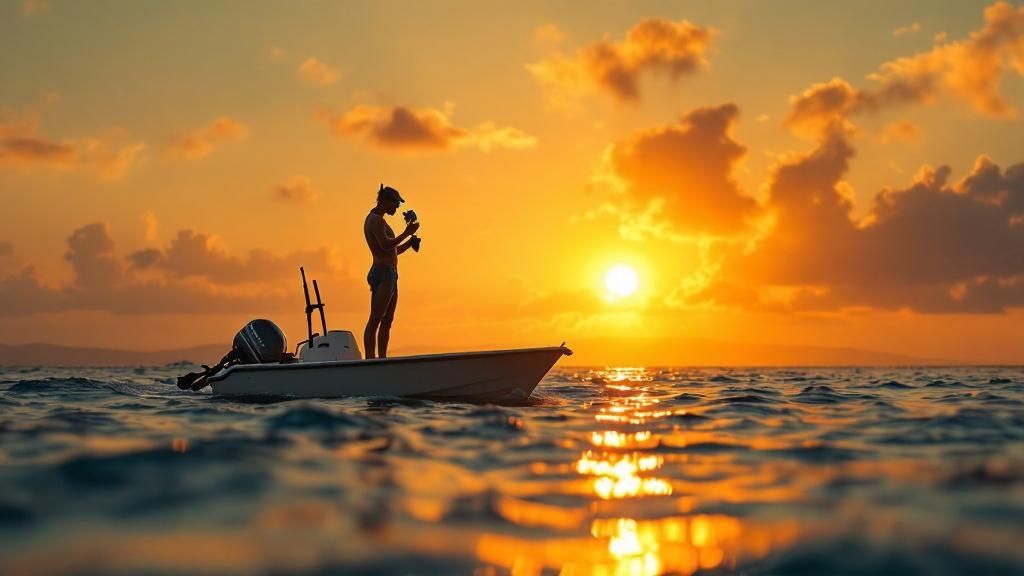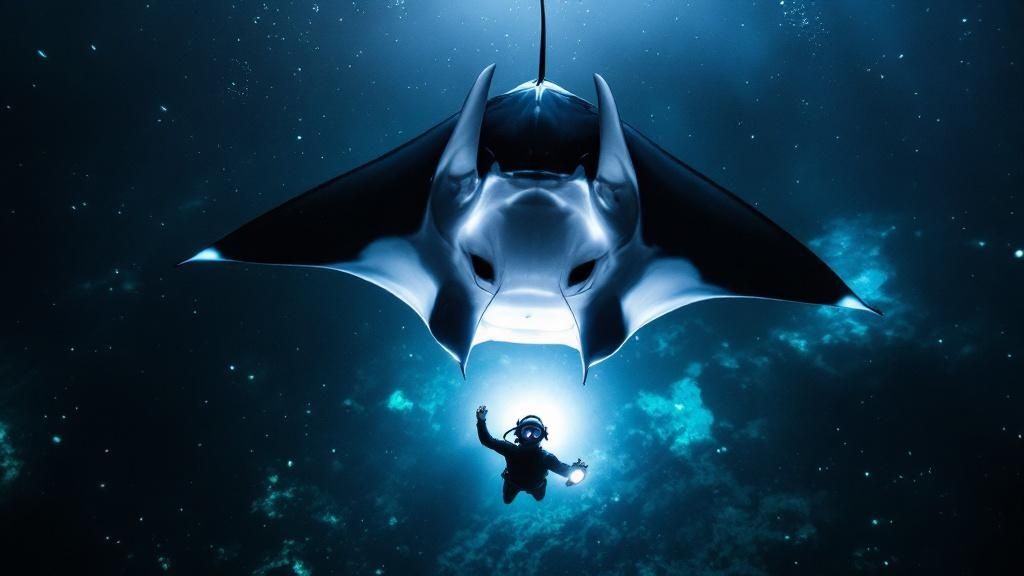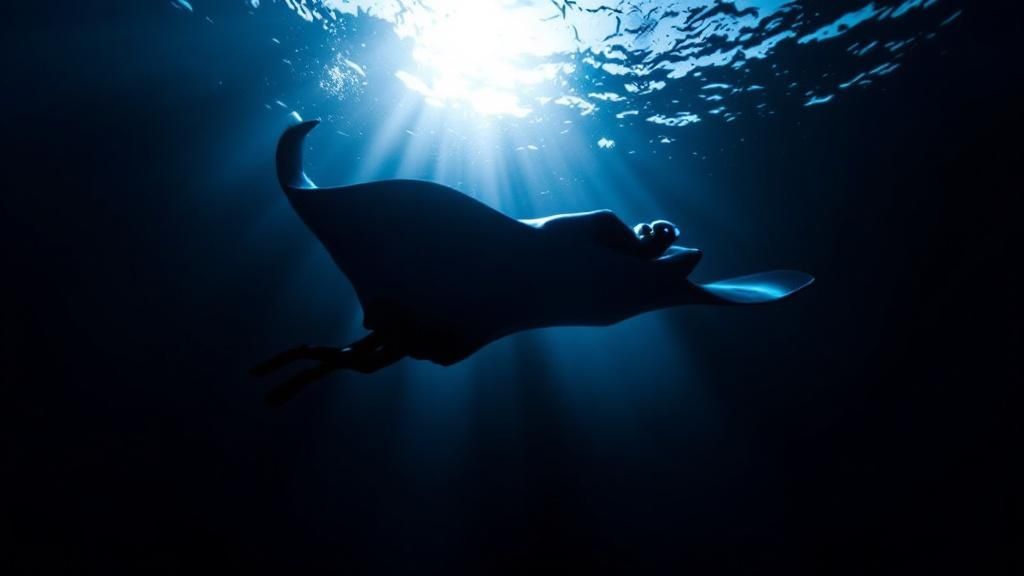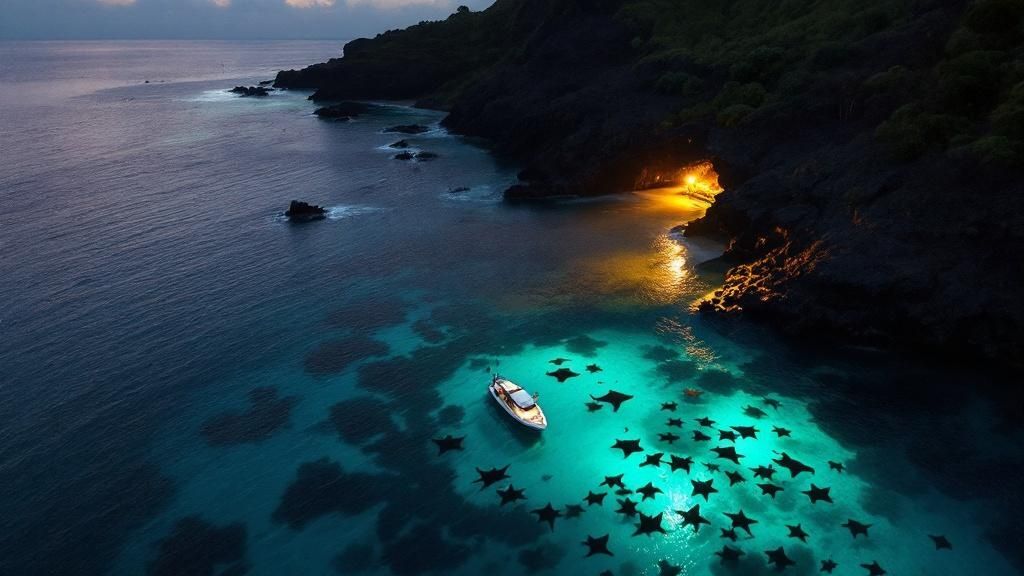Ultimate Manta Ray Snorkel Big Island Guide | Experience the Magic
- Byron
- Jul 31
- 12 min read
Picture this: you’re floating under a sky filled with stars, looking down into the dark Hawaiian water. Suddenly, a gentle giant with a wingspan wider than a car glides right below you. That's the magic of the manta ray snorkel Big Island experience—a true bucket-list adventure that feels like you've entered another world. This is more than just a boat trip; it’s an up-close, underwater ballet. Ready for an adventure of a lifetime? Check out the premier tours at Manta Ray Night Snorkel Hawaii.
Your Guide to an Unforgettable Manta Ray Encounter

There's a reason Hawaii's Kona coast is famous for manta ray encounters—it's one of the most reliable places on the entire planet to see them. Local tour operators have figured out a brilliant method to attract these majestic creatures safely and consistently, night after night. You can see what fellow snorkelers are saying about this incredible tour with a top-rated operator like Manta Ray Night Snorkel Hawaii.
This guide is packed with firsthand advice to help you plan an amazing trip. We’ll get into how to pick the right tour, what it’s actually like in the water, and the do's and don'ts of interacting with these incredible animals. My goal is to make sure your experience is safe, respectful, and absolutely breathtaking.
The Magic of the Manta Dance
So, how does it all work? It's all about the plankton. After the sun goes down, tour boats head out to specific, well-established feeding sites. Once they anchor, powerful lights are lowered into the ocean. These lights act like a magnet, attracting huge clouds of microscopic plankton—the mantas' favorite meal.
You'll be holding onto a specially designed float board that also has lights pointing down, creating a brightly lit dinner table for the rays.
The experience is often called an "underwater ballet" for good reason. The mantas perform graceful barrel rolls and swoop within inches of you, their huge mouths open to filter the plankton from the water. It’s an absolutely mesmerizing sight.
This reliable food source is what keeps the mantas coming back. It creates an encounter that feels completely wild yet, thankfully, wonderfully predictable. You're not just watching from a distance; you're part of the action, sharing a moment with one of the ocean's most intelligent and gentle giants.
Planning Your Adventure
This is one activity you don't want to book at the last minute. The best tours, especially the ones with smaller groups and top-notch safety records, fill up fast. I always recommend booking your manta ray snorkel adventure for a night early in your vacation. That way, you have some wiggle room to reschedule if bad weather or rough seas cause a rare cancellation.
Here are a few things to keep in mind as you plan:
Year-Round Fun: The mantas live here all year, so you can do this tour any time. Summer months often mean calmer water, but the experience is spectacular no matter the season.
Swimming Skills: You don’t need to be Michael Phelps. You'll be holding onto a float board the whole time, and the wetsuit they provide makes you very buoyant.
Time Commitment: Expect the whole tour to last about two hours. You'll get roughly 45 minutes of in-water time with the mantas, which is plenty to soak it all in.
Ready to see this incredible spectacle for yourself?
How to Choose the Right Manta Ray Tour

Picking the right tour operator is easily the most critical decision you'll make for your manta ray snorkel adventure on the Big Island. It’s a choice that shapes your entire experience. With so many companies vying for your business, knowing what separates a decent tour from a truly exceptional and ethical one is key. This isn't just about what you see; it's about protecting the magnificent creatures you've come to admire.
The best operators are passionate about conservation and love sharing their knowledge with guests. They see themselves as guardians of the mantas, not just tour guides.
What To Look For Before You Book
As you start your research, a few things should be on your radar to help you choose wisely. The size of the group is a big one. Smaller boats almost always mean a more personal, less chaotic experience once you're in the water. You're not just another number.
Another crucial point is the operator's sighting policy. The Kona Coast is one of the most reliable places on Earth for seeing mantas. In fact, historical data shows that mantas have been spotted on about 85-90% of night tours here, though nature never offers a 100% guarantee. Because of this, the best companies stand by their tours with a "second chance" guarantee—if the mantas don't show, you can go again for free on another night.
Don't be shy about asking direct questions before you hand over your credit card. A trustworthy company will be happy to talk about their safety protocols, group capacity, and what happens if you don't see mantas. Their transparency tells you a lot about the quality of their operation.
Finally, think about the location. The two primary sites—Manta Village near Keauhou Bay and Manta Heaven near the airport—offer slightly different vibes. Manta Village is famous for its incredible consistency, while Manta Heaven can sometimes attract a larger congregation of rays. For a full breakdown of these spots and other planning tips, be sure to read our ultimate guide for an unforgettable manta ray snorkel on the Big Island.
Tour Operator Comparison Checklist
It can get a little overwhelming trying to compare different companies. I put together this quick checklist to help you evaluate your options and focus on what really matters.
Feature | What to Look For | Why It Matters |
|---|---|---|
Group Size | Smaller boats, limited number of snorkelers per guide. | A more intimate, less crowded experience in the water and personalized attention. |
Sighting Guarantee | A clear "second chance" policy to rebook for free if no mantas are seen. | Shows confidence in their location and commitment to your experience. |
Safety & Staff | Lifeguard-certified guides, thorough safety briefing, and well-maintained boats. | Your safety is paramount. Experienced guides ensure you feel secure in the water. |
Sustainability | Adherence to "Manta-Safe" guidelines and a focus on education. | Ensures the encounter is respectful and non-disruptive to the manta rays. |
Gear Quality | All-inclusive pricing with high-quality, well-fitting wetsuits and snorkel gear. | A leaky mask or a thin, cold wetsuit can ruin an otherwise amazing night. |
Taking just a few minutes to run through these points will give you peace of mind, knowing you’ve chosen a tour that is safe, respectful, and set up to deliver the incredible memory you’re looking for.
What to Expect on Your Night Snorkel Adventure

It’s completely normal to feel a mix of excitement and maybe a few butterflies before your manta ray snorkel on the Big Island. Knowing how the tour unfolds can help turn those nerves into pure anticipation.
Your adventure kicks off at the harbor. This is where you'll meet the crew, get sized up for a wetsuit, and run through a quick but important safety briefing. If you have any last-minute questions, now’s the perfect time to ask.
Once you’re all set, the boat will head out to one of the famous feeding sites, like Manta Village or Manta Heaven. The ride out is a treat in itself. You’ll get an amazing view of the Kona sunset, and if you’re lucky, you might even spot some spinner dolphins playing in the boat's wake.
The Underwater Buffet
As the boat anchors, the real magic begins. The crew sets up a custom-built light board—think of it as a big floating raft with powerful lights aimed straight down into the ocean. This light is the secret ingredient; it draws in huge clouds of plankton, which is dinner for the manta rays.
You'll slip into the water and grab onto the handles of the light board. The setup is brilliant because you don't need to be an expert swimmer. You just float comfortably and watch the show happen right below you. Your wetsuit gives you all the buoyancy you need, keeping you warm and relaxed.
Your only job is to watch. As plankton swarms the light, the manta rays appear from the dark, gliding and barrel-rolling through the beams to scoop up their meal. It's a silent, mesmerizing ballet happening inches from your face.
The entire experience is captivating. The only sound you'll hear is your own breathing as these gentle giants—some with wingspans stretching over 12 feet—put on their nightly feeding performance. You can read more about what makes this one of the island's top experiences in our guide on what to expect during your manta ray snorkel adventure.
A Few Tips for Staying Comfortable
The more comfortable you are, the more you'll enjoy the show. Here are a few simple tips from my experience:
Get a Snug Wetsuit: Your wetsuit should be snug but not tight. A good fit traps a thin layer of water that your body quickly warms, keeping you toasty for the whole 45-minute swim.
Keep Your Fins Up: In the dark, it’s easy to lose track of your feet. Keep your fins near the surface to avoid accidentally kicking a manta ray or a fellow snorkeler.
Just Relax: This is the most important part. Take slow, steady breaths through your snorkel and let yourself get lost in the incredible view below.
These tours are designed to be safe, comfortable, and an adventure you’ll remember for a lifetime.
Getting to Know the Majestic Kona Manta Rays

The more you know about the incredible creatures you’re about to meet, the more profound your manta ray snorkel on the Big Island will be. These aren't just fish; they are intelligent, ancient beings with deep cultural roots in Hawaii, where they’re known as hāhālua. A little bit of knowledge beforehand changes the tour from a simple activity into a truly meaningful connection.
The mantas you'll encounter are a resident population, which means they live right here off the Kona coast all year. You'll primarily see Reef Manta Rays (Mobula alfredi), the second-largest species on the planet. Their wingspans can stretch to an unbelievable 18 feet!
And don't worry—while they're related to stingrays, mantas have no stingers, no barbs, and no teeth. They are completely harmless and are often called the "gentle giants" of the ocean for good reason. The tours are designed to tap into their natural feeding behavior in a safe way, giving you a front-row seat to their nightly routine without disrupting it.
How We Tell Them Apart
One of the coolest things about Kona's manta rays is that we know them as individuals. Just like a human fingerprint, the pattern of black spots on each manta's white belly is totally unique. This allows researchers and local guides to name them and track their lives, which can span more than 50 years.
Don’t be surprised if your guide gets excited and calls out a name like "Lefty" or "Big Bertha." That personal connection is all thanks to those distinct spot patterns. It’s a powerful feeling when you realize you aren't just seeing a manta ray; you're meeting a recognized member of the local marine community.
The Cultural Significance of Hāhālua
For Hawaiians, the connection to manta rays runs deep. The hāhālua is a creature of great cultural importance and is sometimes regarded as an ʻaumākua—a deified ancestor that acts as a family guardian.
Manta ray tourism is also a huge part of the local economy, bringing in an estimated 80,000 visitors every year. Most come to see the reef mantas, but sometimes they get a bonus sighting of the even larger, migratory giant manta ray (Mobula birostris). The manta ray is even mentioned in the Kumulipo, the sacred Hawaiian creation chant, which just goes to show how intertwined these animals are with the culture and environment. If you’re curious, you can learn more about the manta's role in Hawaiian culture and ecotourism here.
Understanding this cultural context brings a whole new level of respect and awe to the experience. You’re not just observing a natural wonder, but a spiritual guardian.
Ready to meet these gentle giants for yourself?
How to Be a Respectful Manta Ray Observer
The single most important rule for any manta ray snorkel on the Big Island comes down to one simple idea: be a passive observer. Think of it this way—you're a guest invited into their magnificent underwater dining room. How you act determines whether these incredible encounters can continue for years to come.
Above all else, do not touch the manta rays. It’s the number one rule for a reason. These gentle giants have a delicate, slimy coating that acts as a shield against bacteria. When you touch them, you strip away that protective layer, leaving them open to nasty infections. Your guides will tell you this repeatedly, but it’s worth remembering: keep your hands to yourself, no matter how tempting it is when they glide inches away.
The whole idea is to let the mantas control the interaction. Just float, be still, and let them come to you. When they swoop in for a close look, it's a sign that they feel completely safe and comfortable with your presence.
Following these rules isn't just about good manners; it's a crucial part of a bigger conservation picture. Recent research has shown that Hawaiʻi's reef manta rays live in tiny, isolated groups. We're talking about just a few hundred individuals around each island chain. This makes them incredibly fragile. Losing even one manta can have a devastating impact on the local population's ability to survive. You can read more about these vulnerable manta populations to see just how much your actions matter.
Manta Snorkel Best Practices
Your guide will walk you through everything, but here are the key things to keep in mind to be a top-notch, responsible snorkeler.
Go Horizontal: Lie flat on the water's surface while holding onto the light board. This keeps your fins from dangling down where they might accidentally kick a manta swimming below.
Never Give Chase: It might be tempting, but don't ever swim after a manta ray. It stresses them out and can scare them away from the light and their dinner, ruining the show for everyone.
Lights Point Down: Keep your lights pointing straight down toward the seafloor. This is what attracts the plankton. Try not to shine any personal flashlights or camera flashes up into their eyes.
Stay at the Surface: As a snorkeler, your place is on the surface. Diving down into the "manta ballroom" can disrupt their feeding patterns and is a major safety risk.
By sticking to these simple guidelines, you become an active partner in protecting these amazing animals. For more tips on getting ready, check out our guide to the Kona manta ray snorkel experience. Your respect and care ensure that the next group of visitors gets to see the exact same breathtaking underwater ballet.
Your Manta Ray Snorkeling Questions, Answered
Jumping into a new adventure, especially one as unique as swimming with manta rays at night, is bound to bring up a few questions. That's completely normal! We've been doing this for a long time, and we've heard just about every question you can imagine.
So, let's clear things up. Here are some straightforward answers to the questions we get asked most often. We want you to feel totally confident and excited for your tour with Manta Ray Night Snorkel Hawaii.
But first, don't just take our word for it—see what our guests have to say.
Is Seeing Manta Rays Guaranteed?
This is the big one, the question on everyone’s mind. And it’s a fair one!
The good news is that manta ray sightings on the Kona Coast are incredibly consistent, with a success rate that’s often over 90%. But, and this is important, these are wild animals in their natural habitat. There's just no way to ever promise a 100% guarantee.
Any reputable operator will be upfront about this. That's why the best companies offer a "second chance" voucher. If the mantas decide to be shy on your tour night, you can come back and try again for free. It’s a sign of a crew that trusts their spot and is committed to you having an amazing experience.
My best advice? Ask about the sighting policy before you book. And try to schedule your manta tour for one of your first nights on the island. That way, you have plenty of time to reschedule if you need to.
Do I Need to Be a Strong Swimmer?
You definitely don't need to be Michael Phelps, but you should be comfortable in the water. We've designed this experience to be safe and accessible for almost everyone.
You won't actually be swimming around. Instead, you'll be holding onto a large, custom-made light board that floats on the surface. The board is very stable, and the wetsuit we provide adds a lot of buoyancy, so you'll float with very little effort.
Our trained guides are in the water with you the entire time, keeping a close eye on everything. That said, if you have a deep fear of the dark or open water, it’s a good idea to chat with the tour company beforehand. They can help address your concerns and make sure you feel at ease.
What Is the Best Time of Year for This Tour?
Here’s one of the coolest things about the manta ray snorkel Big Island experience: it’s fantastic all year long! The mantas are residents here, not just passing through, so there really isn't an "off-season."
Summer months, from around April to October, tend to have calmer seas, which can make for a smoother boat ride. But honestly, we have incredible nights in every season. The biggest factor isn't the month, but the day-to-day ocean swell.
This is another reason why booking your trip early in your vacation is a smart move. It gives you a built-in buffer in case we have to reschedule due to high surf or unpredictable weather.
What Should I Bring on the Boat?
We've got you covered with all the main gear—high-quality wetsuits, masks, and snorkels are all provided. You just need to pack a small bag with a few personal items to make your trip more comfortable.
Here’s a quick checklist of what I always recommend:
A towel for after you get out of the water.
Something warm to wear for the ride back. A sweatshirt or light jacket is perfect for when the post-snorkel chill sets in.
Motion sickness medicine if you're prone to it. It's best to take it before you get on the boat.
A reusable water bottle to stay hydrated.
Your camera! You won’t want to miss capturing that incredible Kona sunset from the boat.
Most importantly, just bring your sense of wonder. You're about to see something truly unforgettable.
Comments